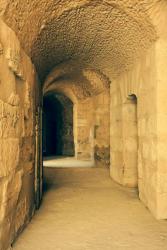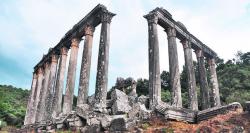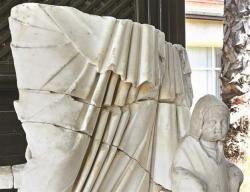INSTITUT SUPERIEUR D'ANTHROPOLOGIE
INSTITUTE OF ANTHROPOLOGY
ONLINE COURSES / COURS A DISTANCE
FALL TERM : OCTOBER 2015
REGISTER NOW
ITALIE – 
 Rome - Ancient underground tunnel that links Colosseum with remains of gladiatorial training barracks could be restored. Generations of gladiators lived and trained in the Ludus Magnus or Great Gladiatorial Training School, the largest such facility in Rome, which was located just a few hundred yards from the amphitheatre. The remains of the training school can still be seen, squeezed between two busy roads in the shadow of the Colosseum and frequently littered with rubbish. The authorities in Rome have long wanted to restore the archaeological site and open up the tunnel which leads from the barracks into the bowels of the Colosseum. Gladiators would don their helmets and armour and collect their weapons before walking through the torchlit passageway to emerge onto the sandy arena of the amphitheatre, in scenes depicted memorably by the Ridley Scott film Gladiator, starring Russell Crowe.
Rome - Ancient underground tunnel that links Colosseum with remains of gladiatorial training barracks could be restored. Generations of gladiators lived and trained in the Ludus Magnus or Great Gladiatorial Training School, the largest such facility in Rome, which was located just a few hundred yards from the amphitheatre. The remains of the training school can still be seen, squeezed between two busy roads in the shadow of the Colosseum and frequently littered with rubbish. The authorities in Rome have long wanted to restore the archaeological site and open up the tunnel which leads from the barracks into the bowels of the Colosseum. Gladiators would don their helmets and armour and collect their weapons before walking through the torchlit passageway to emerge onto the sandy arena of the amphitheatre, in scenes depicted memorably by the Ridley Scott film Gladiator, starring Russell Crowe.
http://www.telegraph.co.uk/news/worldnews/europe/italy/11651780/Gladiator-school-to-be-restored-in-Rome.html
TURQUIE –  Euromos - better coordinate the excavations in the ancient city of Euromos situated near the Milas district of Muğla, a special house will be open soon for the archaeological team. Speaking to Anadolu Agency, Assistant Professor Abuzer Kızıl of the Muğla Sıtkı Koçman University Archaeology Department and also the head of the excavations, said that the excavations in the ancient city of Euromos, which was founded in the second century B.C., started 36 years earlier. In recent years the excavation team has carried out geophysical studies, excavations, mapping, cleaning and have opened culverts. The activities are currently focused on the Temple of Zeus, ancient theater, necropolis, bathhouse, city walls and agora. He said dedicated housing, storage and workspace is needed in order to properly conduct the ongoing excavations. Kızıl said the excavations will restart soon in the area after a break. "A well-equipped building is a priority to successfully conduct excavations. So far, our team has stayed in a dormitory of the Milas National Education Directorate," he said. The team can stay in the dormitory only during specified periods and thereby has to work hard for a whole month in summer. "When the house is completed, the excavations will continue for between five and six months. Kızıl spoke of the Temple of Zeus, one of the best-preserved temples in Anatolia, built in the second century B.C.: "There are 16 pillars of the temple, which had 17, still standing. The archaeological team is planning to realize important projects there. There are many well-preserved architectural ruins," he said. Last year a marble chair belonging to one of a nobleman was found near the ancient theater. "Under a two-meter fill, we discovered a 2,200-year-old chair. This year the excavations will continue in the same area," he said. The research team also carried out a topographic survey and geophysical studies, which form an important aspect of the excavations.
Euromos - better coordinate the excavations in the ancient city of Euromos situated near the Milas district of Muğla, a special house will be open soon for the archaeological team. Speaking to Anadolu Agency, Assistant Professor Abuzer Kızıl of the Muğla Sıtkı Koçman University Archaeology Department and also the head of the excavations, said that the excavations in the ancient city of Euromos, which was founded in the second century B.C., started 36 years earlier. In recent years the excavation team has carried out geophysical studies, excavations, mapping, cleaning and have opened culverts. The activities are currently focused on the Temple of Zeus, ancient theater, necropolis, bathhouse, city walls and agora. He said dedicated housing, storage and workspace is needed in order to properly conduct the ongoing excavations. Kızıl said the excavations will restart soon in the area after a break. "A well-equipped building is a priority to successfully conduct excavations. So far, our team has stayed in a dormitory of the Milas National Education Directorate," he said. The team can stay in the dormitory only during specified periods and thereby has to work hard for a whole month in summer. "When the house is completed, the excavations will continue for between five and six months. Kızıl spoke of the Temple of Zeus, one of the best-preserved temples in Anatolia, built in the second century B.C.: "There are 16 pillars of the temple, which had 17, still standing. The archaeological team is planning to realize important projects there. There are many well-preserved architectural ruins," he said. Last year a marble chair belonging to one of a nobleman was found near the ancient theater. "Under a two-meter fill, we discovered a 2,200-year-old chair. This year the excavations will continue in the same area," he said. The research team also carried out a topographic survey and geophysical studies, which form an important aspect of the excavations.
http://www.dailysabah.com/arts-culture/2015/06/06/ancient-city-to-host-an-excavation-center
BELIZE - Benque Viejo del Carmen - A new excavation on an archaeological site in Benque Viejo del Carmen has begun. As part of the US Ambassador’s Cultural Preservation Grant fund, the preservation of the archaeological site now employs several Benque Viejo residents. On our most recent visit to the Benque Site, which is located by the Belize Water Services Ltd Pump in Benque Viejo, both Carlos Mendez and Merli Alfaro, as well as other workers were busy exposing the façade of a site that is now believed to have been the household of a rural Maya elite family. The archaeological site itself may have been part of a network derived from the ancient city of Xunantunich, which can be viewed about a kilometer to the northwest from atop a mound at the Benque site. According to George Thompson, Associate Director for Belize’s Parks Management, work began on the Benque Viejo site about a month ago to do regular excavation in an effort to expose the architecture. He said that the final step will be to conserve the site so that it becomes part of a heritage trail.
http://www.guardian.bz/all-politics/9592-archaeological-site-in-benque-viejo-del-carmen-now-being-excavated
SUISSE –  Avenches - All over Europe, the Romans founded cities which still stand today. Like Aventicum in western Switzerland, now about 2,000 years old. In Aventicum’s heyday, it had several public baths, a theatre, a forum, a temple, arches, opulent houses with mosaics and heating systems, and a magnificent amphitheatre, which is still in use. Many of the ruins can still be visited in the town now called Avenches. The city was created as the capital of the conquered territory of the Helvetii. In 72AD, it was raised to the status of a colonia, a retirement place for legionaries. This encouraged land development and stability, and heralded a golden age for Aventicum. The population grew to 20,000.
Avenches - All over Europe, the Romans founded cities which still stand today. Like Aventicum in western Switzerland, now about 2,000 years old. In Aventicum’s heyday, it had several public baths, a theatre, a forum, a temple, arches, opulent houses with mosaics and heating systems, and a magnificent amphitheatre, which is still in use. Many of the ruins can still be visited in the town now called Avenches. The city was created as the capital of the conquered territory of the Helvetii. In 72AD, it was raised to the status of a colonia, a retirement place for legionaries. This encouraged land development and stability, and heralded a golden age for Aventicum. The population grew to 20,000.
http://www.swissinfo.ch/eng/roman-remains_celebrating-2-000-years-of-aventicum/41464794?
INDE – Fatehpur Sikri- Unknown to most, around 45 km from Agra at a height of 150 feet, there were until just some years ago, 40 sites of grand cave paintings and shelters that belong to the Mesolithic (Stone Age) period. Today, there are just a few left. Most have been lost to illegal stone mining and the utter disregard of both authorities and the government for history and heritage. When TOI visited the four villages -- Rasoolpur, Patsal, Madanpura and Bandroli - where this ancient art is located, it found that almost 70% of the paintings had been destroyed, and only the efforts of a few persevering villagers had enabled the remaining specimens to somehow escape destruction. The remaining paintings, some still shining out in colours of maroon and ochre, show ancient men domesticating cattle as well as engaged in hunting. Some have pictures depicting animals like elephant and bull. The best specimens, though, are at Patsal where there are two sites locally known as Sita ki Rasoi and Nai Ki Gufa. Sita ki Rasoi is a natural cave situated at a height of 150 feet where ancient men probably lived. Inside it, there is depiction of a character that looks like a bison. At Nai ki Gufa, deer and sambhar can be seen in the paintings.
http://timesofindia.indiatimes.com/city/agra/Ancient-cave-art-near-Fatehpur-Sikri-on-verge-of-being-wiped-out-/articleshow/47575812.cms
TURQUIE –  Perge - The head of Telesphoros, which symbolized recovery from illness for the ancient Greeks, has been found after 34 years. The sculpture was first unearthed in 1981 in one of the oldest excavation areas, the ancient city of Perge. Telesphoros was the son of Asclepius, the god of medicine. The head of the Perge excavations and Antalya Museum Director Mustafa Demirel said that excavations had started in the ancient city back in 1946. He said that the sculpture of 2nd century A.D. Asclepius was found in two pieces by Turkey’s first female archaeologist, Professor Jale İnan, in the southern bath. The sculpture, which is made up of one foot, two pieces of a body (symbolizing Asclepius) and a child’s body (symbolizing Telesphoros), was brought to the museum. “Thirty-four years have passed since then. We were cleaning the street in front of the Hellenistic tower next to an ancient bath. We found a child’s head close to the surface. It was carried to the museum, where we saw that the head belonged to Telesphoros. The sculpture was in the backyard of the museum. Restorers confirmed it, and we then attached the head to the body,” said Demirel, adding that they hoped to find the sculpture’s other missing pieces.
Perge - The head of Telesphoros, which symbolized recovery from illness for the ancient Greeks, has been found after 34 years. The sculpture was first unearthed in 1981 in one of the oldest excavation areas, the ancient city of Perge. Telesphoros was the son of Asclepius, the god of medicine. The head of the Perge excavations and Antalya Museum Director Mustafa Demirel said that excavations had started in the ancient city back in 1946. He said that the sculpture of 2nd century A.D. Asclepius was found in two pieces by Turkey’s first female archaeologist, Professor Jale İnan, in the southern bath. The sculpture, which is made up of one foot, two pieces of a body (symbolizing Asclepius) and a child’s body (symbolizing Telesphoros), was brought to the museum. “Thirty-four years have passed since then. We were cleaning the street in front of the Hellenistic tower next to an ancient bath. We found a child’s head close to the surface. It was carried to the museum, where we saw that the head belonged to Telesphoros. The sculpture was in the backyard of the museum. Restorers confirmed it, and we then attached the head to the body,” said Demirel, adding that they hoped to find the sculpture’s other missing pieces.
http://www.hurriyetdailynews.com/head-of-telesphoros-found-after-34-years-.aspx?pageID=238&nid=83602&NewsCatID=375
BULGARIE –  Pavlikeni - A total of four ovens, or furnaces, for baking pottery and an ancient water well have been discovered by the three teams of archaeologists working on the rescue excavations in the northern Bulgarian town of Pavlikeni which is rehabilitating its water supply and sewerage system. Late week, the archaeologists in Pavlikeni discovered Ancient Roman ceramic vessels from the period of the Late Antiquity, the 2nd-3rd century AD. They point out that the newly found pottery baking ovens in the town of Pavlikeni are just like the more than 50 furnaces in the Ancient Roman ceramic factory located in a Roman military veteran’s villa outside the modern-day town. The archaeologists also found a water well located about 1.5 meters below the streets of today’s Pavlikeni, with water springing from it when it was reached. The new discoveries prove that the modern-day town lies on top of an Ancient Roman town, or in the very least, a Roman villa estate, whose name is unknown.
Pavlikeni - A total of four ovens, or furnaces, for baking pottery and an ancient water well have been discovered by the three teams of archaeologists working on the rescue excavations in the northern Bulgarian town of Pavlikeni which is rehabilitating its water supply and sewerage system. Late week, the archaeologists in Pavlikeni discovered Ancient Roman ceramic vessels from the period of the Late Antiquity, the 2nd-3rd century AD. They point out that the newly found pottery baking ovens in the town of Pavlikeni are just like the more than 50 furnaces in the Ancient Roman ceramic factory located in a Roman military veteran’s villa outside the modern-day town. The archaeologists also found a water well located about 1.5 meters below the streets of today’s Pavlikeni, with water springing from it when it was reached. The new discoveries prove that the modern-day town lies on top of an Ancient Roman town, or in the very least, a Roman villa estate, whose name is unknown.
http://archaeologyinbulgaria.com/2015/06/06/archaeologists-find-pottery-ovens-in-unknown-roman-town-in-rescue-excavations-in-bulgarias-pavlikeni/